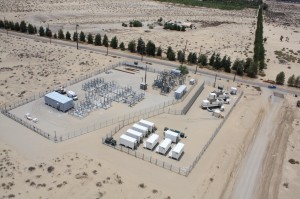As the price of solar panels and batteries decreases, our electricity system is starting to look a lot cleaner and more decentralized. While some people think the rise of community-based electricity technologies will undermine utilities, utilities are in fact embracing one version of decentralized power: microgrids.
Utilities are finding microgrids to be a great resilience strategy for avoiding outages, particularly in rural areas or crucial population or job centers. Greentech Media reports on the trend:
San Diego Gas & Electric delivers power to the town of Borrego Springs via a single radial transmission line running through the desert. Lightning strikes and desert flash floods threaten that line, resulting in historically poor reliability, Chief Engineer Thomas Bialek explained at the DistribuTech panel.
The utility needed to maintain or improve reliability for the nearly 2,800 Borrego Springs customers, but the traditional fix — building out a parallel transmission line — was pricey. A microgrid would be three or four times cheaper, Bialek said. So that’s what they did.The system, paid for by SDG&E, the Department of Energy and other partners, combines diesel generators, large and small batteries, and rooftop solar PV.
The microgrid has already proven itself in the face of adversity. When a flash flood in September 2013 downed transmission poles and lines leading to the town, the microgrid fired up and restored power to 1,056 customers while the grid repairs unfolded. That covered the core city center, so that those residents who didn’t have power yet could move to central facilities for shelter from the heat.
The future portends even more investment in microgrids, as Utility Dive notes:
Last year, GTM Research estimated there were 156 operational microgrids in the country, making up 1.54 GW of capacity, and that number is expected to rise to 3.71 GW by 2020. Globally, Transparency Market Research believes the microgrid market will be worth about $35 billion by 2020 — up from $10 billion in 2013.
But as microgrids — and the technologies that underpin them — become cheaper, utilities may be sowing the seeds of their own destruction. With a few additional breakthroughs, these technologies could eventually allow entire communities to defect from the grid, leaving utilities and their remaining ratepayers stuck with stranded assets.
But for now, these installations will provide an environmental and energy win, while furthering investment in the technologies needed to clean and decentralize the electricity sector.



